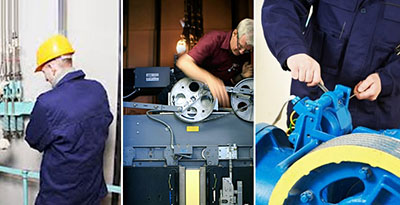Budget Friendly Lift Servicing Options for Residential and Commercial Use
Budget Friendly Lift Servicing Options for Residential and Commercial Use
Blog Article
Extensive Elevator Solution Strategy Incorporating Troubleshooting, Adjustment, and Calibration
In the realm of vertical transport systems, elevators play an essential role in making certain reliable movement within structures. A thorough elevator solution prepare that incorporates calibration, troubleshooting, and modification is not just a routine maintenance timetable; it is a detailed method to elevating the efficiency and security criteria of these important mechanisms.

Importance of Lift Upkeep
Elevator maintenance is a critical facet of guaranteeing the reliable and safe operation of a structure's upright transportation system. Routine upkeep not only extends the life expectancy of the elevator but likewise decreases the risk of unforeseen failures, making sure the safety of residents. By sticking to an organized upkeep plan, building owners and facility managers can determine and resolve potential concerns before they intensify into major problems, therefore lowering downtime and costly repair services.
Routine maintenance tasks include lubing and evaluating relocating components, screening safety features, and readjusting systems to preserve optimum efficiency. In addition, normal upkeep aids to make sure that the elevator adheres to security laws and requirements set by appropriate authorities. Overlooking maintenance can result in malfunctions, such as abrupt quits in between floorings, door problems, or electrical failures, all of which can inconvenience individuals and jeopardize their security.
Troubleshooting Techniques for Lifts
Ensuring the risk-free and efficient operation of a building's vertical transport system with normal maintenance likewise includes the application of effective fixing techniques for attending to potential lift issues without delay. Troubleshooting strategies for elevators are vital to keeping a trustworthy elevator service.
An additional important troubleshooting strategy is conducting an extensive physical examination of the elevator parts. This entails checking for any type of indicators of wear and tear, loosened links, or uncommon sounds during procedure. By visually examining the lift equipment and electric systems, specialists can determine prospective concerns prior to they escalate into major problems.
Furthermore, repairing techniques for elevators typically entail screening numerous safety and security functions, such as emergency situation brakes and door sensors, to ensure they are functioning correctly. Frequently checking these security devices can aid prevent accidents and ensure passenger security. By integrating these fixing methods into an elevator service strategy, structure proprietors can lessen downtime, minimize repair service expenses, and ensure a smooth upright transportation experience for residents.
Precision Adjustments in Lift Solution
Executing specific modifications is paramount in preserving the optimal performance and performance of lift systems within a building. lift servicing. Elevators are intricate mechanical systems that need thorough fine-tuning to ensure reliable and smooth operation. Accuracy changes play a vital duty in improving safety and security, reducing downtime, and extending the lifespan of elevator elements
When performing accuracy adjustments in elevator service, technicians should have a deep understanding of the system's mechanics and dynamics. Small variances in rate, positioning, or progressing can bring about considerable concerns otherwise addressed quickly. By very carefully adjusting criteria such as door closing times, leveling precision, and velocity prices, technicians can enhance the general performance of the elevator.
Furthermore, precision modifications assist stop premature damage on crucial components, such as cable televisions, sheaves, and control systems. On a regular basis set up upkeep that includes fine-tuning changes can minimize the threat of unanticipated failures and pricey repair services. Lift provider ought to prioritize precision modifications as part of their extensive maintenance strategies to maintain the greatest standards of reliability and passenger safety and security.
The Value of Calibration Procedures

Calibration processes likewise play an essential role in lengthening the lifespan of elevator devices. Normal calibration aids identify possible issues beforehand, article permitting prompt news changes or substitutes before significant troubles occur. This positive strategy not only stops costly downtime yet additionally contributes to the general integrity of the lift system.
Furthermore, calibration is vital for making certain compliance with industry guidelines and criteria. By adhering to manufacturer recommendations and market ideal practices during calibration procedures, elevator provider can ensure that the system fulfills all necessary security demands. Appropriately adjusted lifts not just improve customer experience however likewise show a dedication to traveler security and structure code conformity.
Enhancing Lift Performance and Longevity
To enhance elevator efficiency and extend its durability, an extensive upkeep routine is vital. Regular upkeep not only makes sure that the lift operates successfully however additionally assists in recognizing prospective concerns before they intensify, thereby lowering downtime and expensive repair services.
Furthermore, implementing modern innovations like IoT sensing units and predictive maintenance software program can supply real-time data on elevator efficiency, enabling anticipating upkeep organizing and minimizing unforeseen failures. Upgrading click resources older lift systems with energy-efficient parts can also contribute to better performance and minimized power intake, resulting in set you back savings over time. By focusing on regular upkeep, adopting new modern technologies, and thinking about system upgrades, building proprietors can considerably improve lift efficiency and lengthen its lifespan, guaranteeing smooth operations for visitors and residents alike.

Verdict
By executing troubleshooting strategies, accuracy modifications, and calibration processes, lift service providers can improve the overall functionality of lifts. Investing in a comprehensive lift service strategy is necessary for making the most of the life-span of lifts and guaranteeing smooth transport for developing occupants.
Repairing techniques for lifts are vital to maintaining a reliable lift service.Moreover, implementing modern technologies like IoT sensing units and anticipating upkeep software application can provide real-time information on lift efficiency, allowing predictive upkeep organizing and minimizing unanticipated malfunctions (elevator repair). By focusing on regular upkeep, taking on new technologies, and thinking about system upgrades, building owners can dramatically enhance lift performance and lengthen its lifespan, guaranteeing smooth procedures for occupants and visitors alike
By implementing repairing techniques, precision modifications, and calibration procedures, lift solution providers can improve the total functionality of elevators. Investing in a thorough lift solution strategy is essential for optimizing the life-span of elevators and ensuring smooth transportation for developing occupants.
Report this page